The SandForce Roundup: Corsair, Kingston, Patriot, OCZ, OWC & MemoRight SSDs Compared
by Anand Lal Shimpi on August 11, 2011 12:01 AM ESTAnandTech Storage Bench 2011
Last year we introduced our AnandTech Storage Bench, a suite of benchmarks that took traces of real OS/application usage and played them back in a repeatable manner. I assembled the traces myself out of frustration with the majority of what we have today in terms of SSD benchmarks.
Although the AnandTech Storage Bench tests did a good job of characterizing SSD performance, they weren't stressful enough. All of the tests performed less than 10GB of reads/writes and typically involved only 4GB of writes specifically. That's not even enough exceed the spare area on most SSDs. Most canned SSD benchmarks don't even come close to writing a single gigabyte of data, but that doesn't mean that simply writing 4GB is acceptable.
Originally I kept the benchmarks short enough that they wouldn't be a burden to run (~30 minutes) but long enough that they were representative of what a power user might do with their system.
Not too long ago I tweeted that I had created what I referred to as the Mother of All SSD Benchmarks (MOASB). Rather than only writing 4GB of data to the drive, this benchmark writes 106.32GB. It's the load you'd put on a drive after nearly two weeks of constant usage. And it takes a *long* time to run.
1) The MOASB, officially called AnandTech Storage Bench 2011 - Heavy Workload, mainly focuses on the times when your I/O activity is the highest. There is a lot of downloading and application installing that happens during the course of this test. My thinking was that it's during application installs, file copies, downloading and multitasking with all of this that you can really notice performance differences between drives.
2) I tried to cover as many bases as possible with the software I incorporated into this test. There's a lot of photo editing in Photoshop, HTML editing in Dreamweaver, web browsing, game playing/level loading (Starcraft II & WoW are both a part of the test) as well as general use stuff (application installing, virus scanning). I included a large amount of email downloading, document creation and editing as well. To top it all off I even use Visual Studio 2008 to build Chromium during the test.
The test has 2,168,893 read operations and 1,783,447 write operations. The IO breakdown is as follows:
| AnandTech Storage Bench 2011 - Heavy Workload IO Breakdown | ||||
| IO Size | % of Total | |||
| 4KB | 28% | |||
| 16KB | 10% | |||
| 32KB | 10% | |||
| 64KB | 4% | |||
Only 42% of all operations are sequential, the rest range from pseudo to fully random (with most falling in the pseudo-random category). Average queue depth is 4.625 IOs, with 59% of operations taking place in an IO queue of 1.
Many of you have asked for a better way to really characterize performance. Simply looking at IOPS doesn't really say much. As a result I'm going to be presenting Storage Bench 2011 data in a slightly different way. We'll have performance represented as Average MB/s, with higher numbers being better. At the same time I'll be reporting how long the SSD was busy while running this test. These disk busy graphs will show you exactly how much time was shaved off by using a faster drive vs. a slower one during the course of this test. Finally, I will also break out performance into reads, writes and combined. The reason I do this is to help balance out the fact that this test is unusually write intensive, which can often hide the benefits of a drive with good read performance.
There's also a new light workload for 2011. This is a far more reasonable, typical every day use case benchmark. Lots of web browsing, photo editing (but with a greater focus on photo consumption), video playback as well as some application installs and gaming. This test isn't nearly as write intensive as the MOASB but it's still multiple times more write intensive than what we were running last year.
As always I don't believe that these two benchmarks alone are enough to characterize the performance of a drive, but hopefully along with the rest of our tests they will help provide a better idea.
The testbed for Storage Bench 2011 has changed as well. We're now using a Sandy Bridge platform with full 6Gbps support for these tests. All of the older tests are still run on our X58 platform.
AnandTech Storage Bench 2011 - Heavy Workload
We'll start out by looking at average data rate throughout our new heavy workload test:

Our Storage Bench suite groups performers according to die count/drive capacity. The 240GB drives are faster than the 120GB counterparts. There's also not much of a difference between the drives with synchronous vs. asynchronous NAND.
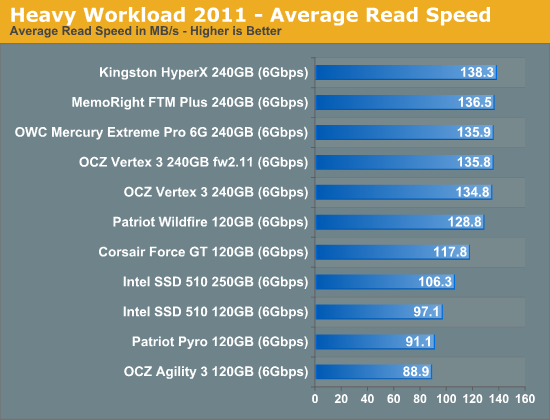
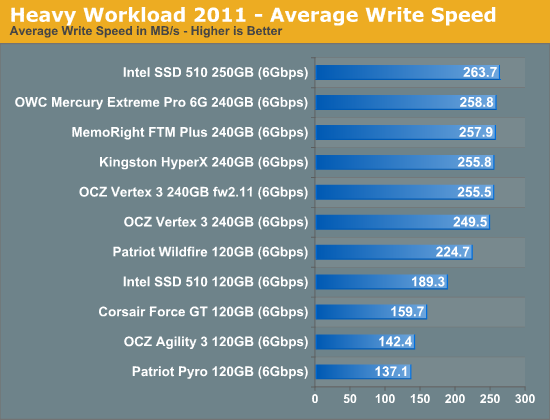
The next three charts just represent the same data, but in a different manner. Instead of looking at average data rate, we're looking at how long the disk was busy for during this entire test. Note that disk busy time excludes any and all idles, this is just how long the SSD was busy doing something:
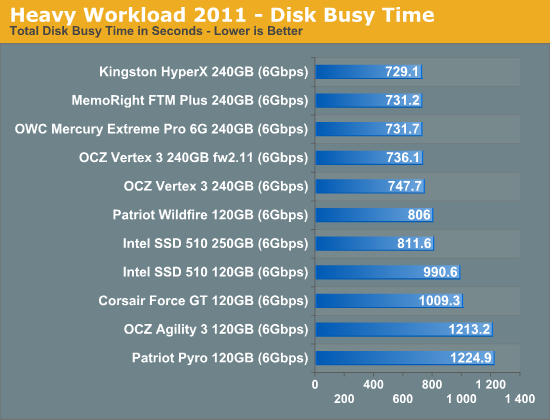
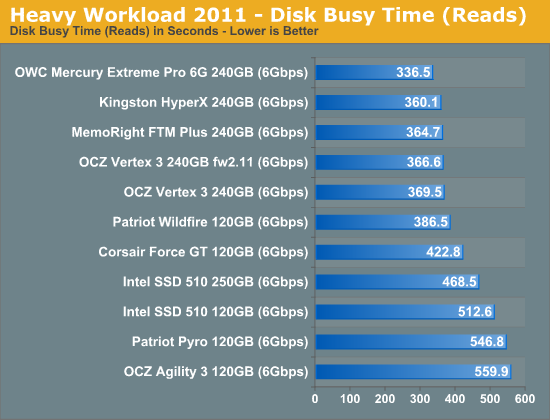
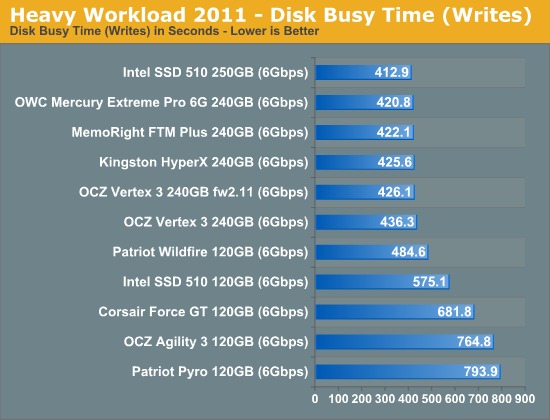










90 Comments
View All Comments
arklab - Thursday, August 11, 2011 - link
A pity you didn't get the new ... err revised OWC 240GB Mercury EXTREME™ Pro 6G SSD.It now uses the SandForce 2282 controller.
While said to be similar to the troubled 2281, I'm wondering if it is different enough to side step the BSOD bug.
It may well also be faster - at least by a bit.
Only the 240GB has the new controller, not there 120GB - though the 480 will also be getting it "soon".
PLEASE get one, test, and add to this review!
cigar3tte - Thursday, August 11, 2011 - link
Anand mentioned that he didn't see any BSOD's with the 240GB drives he passed out. AFAIK, only the 120GB drives have the problem.Also, the BSOD is only when you are running the OS on the drive. So if you have the drive as an addon, you'd just lose the drive, but no BSOD, I believe.
I returned my 120GB Corsair Force 3 and got a 64GB Micro Center SSD (the first SandForce controller) instead.
jcompagner - Sunday, August 14, 2011 - link
ehh,, i have one of the first 240GB vertex 3 in my Dell XPS17 sandy bridge laptop.with the first firmware 2.02 i didn't get BSOD after i got Windows 7 64bit installed right (using the intel drivers, fixing the LPM settings in the registry)
everything was working quite right
then we got 2 firmware version who where horrible BSOD almost any other day. Then we get 2.09 which OCZ says thats a bit of an debug/intermediate release not really a final release. And what is the end result? ROCK STABLE!! no BSOD at all anymore.
But then came the 2.11 release they stressed that everybody should upgrade and also upgrade to the latest 10.6 intel drivers.. I thought ok lets do it then.
In 2 weeks: 3 BSOD, at least 2 of them where those F6 errors again..
Now i think it is possible to go back to 2.09 again, which i am planing to do if i got 1 more hang/BSOD ...
geek4life!! - Thursday, August 11, 2011 - link
I thought OCZ purchasing Indilnx was to have their own drives made "In house".To my knowledge they already have some drives out that use the Indilnx controller with more to come in the future.
I would like your take on this Anand ?
zepi - Thursday, August 11, 2011 - link
How about digging deeper into SSD behavior in server usage?What kind of penalties can be expected if daring admins use couple of SSD's in a raid for database / exchange storage? Or should one expect problems if you run a truckload of virtual machines from reasonably priced a raid-5 of MLC-SSD's ?
Does the lack of trim-support in raid kill the performance and which drivers are the best etc?
cactusdog - Thursday, August 11, 2011 - link
Great review but Why wouldnt you use the latest RST driver? Supposed to fix some issues.Bill Thomas - Thursday, August 11, 2011 - link
What's your take on the new EdgeTech Boost SSD's?ThomasHRB - Thursday, August 11, 2011 - link
Thanks for another great article Anand, I love reading all the articles on this site. I noticed that you have also managed to see the BSOD issues that others are having.I don't know if my situation is related, but from personal experience and a bit of trial and error I found that by unstable power seems to be related to the frequency of these BSOD events. I recently built a new system while I was on holiday in Brisbane Australia.
Basic Specs:
Mainboard - Gigabyte GA-Z68X-UD3R-B3
Graphics - Gigabyte GV-N580UD-15I
CPU - Intel Core i72600K (stock clock)
Cooler - Corsair H60 (great for computer running in countries where ambient temp regularly reach 35degrees Celsius)
PSU -Corsair TX750
In Brisbane my machine ran stable for 2 solid weeks (no shutdown's only restart during software installations, OS updates etc).
However when I got back to Fiji, and powered up my machine, I had these BSOD's every day or 2 (I shutdown my machine during the days when I am at work and at night when I am asleep) (CPU temp never exceeded 55degrees C measured with CoreTemp and RealTemp) and GPU temp also never went above 60degrees C measured with nvidia gadget from addgadget.com)
All my computer's sit behind an APC Back-UPS RS (BR1500). I also have an Onkyo TX-NR609 hooked up to the HDMI-mini port, so I disconnected that for a few days, but i saw no differences.
However last Friday, a major power spike caused my Broadband router (dlink DIR-300) to crash, and I had to reset the unit to get it working. My machine also had a BSOD at that exact same moment. so I thought that it was a possibility that I was getting a power spike being transmitted through the Ethernet cable from my ISP (the only thing that I have not got an isolation unit for)
So the next day I bough and installed an APC ProtectNET (PNET1GB) and I have not had a single BSOD running for almost 1 full week (no shutdown's and my Onkyo has been hooked back up).
Although this narrative is long and reflects nothing more than my personal experiences, I at least found it strange that my BSOD seems to have nothing to do with the Vertex3 and more to do with random power fluctuations in my living environment.
And it may be possible that other people are having the same problem I had, and attributing it to a particular piece of hardware simply because other people have done the same attribution.
Kind Regards.
Thomas Rodgers
etamin - Thursday, August 11, 2011 - link
Great article! The only thing that's holding me back from buying an SSD is that secure data erasing is difficult on an SSD and a full rewrite of the drive is neither time efficient nor helpful to the longevity of the drive...or so I have heard from a few other sources. What is your take on this secure deletion dilemma (if it actually exists)?lyeoh - Friday, August 12, 2011 - link
AFAIK erasing a "conventional" 1 TB drive is not very practical either ( takes about 3 hours).Options:
a) Use encryption, refer to the "noncompressible" benchmarks, use the more reliable SSDs, and use hardware acceleration or fast CPUs e.g. http://www.truecrypt.org/docs/?s=hardware-accelera...
b) Use physical destruction - e.g. thermite, throwing it into lava, etc :).